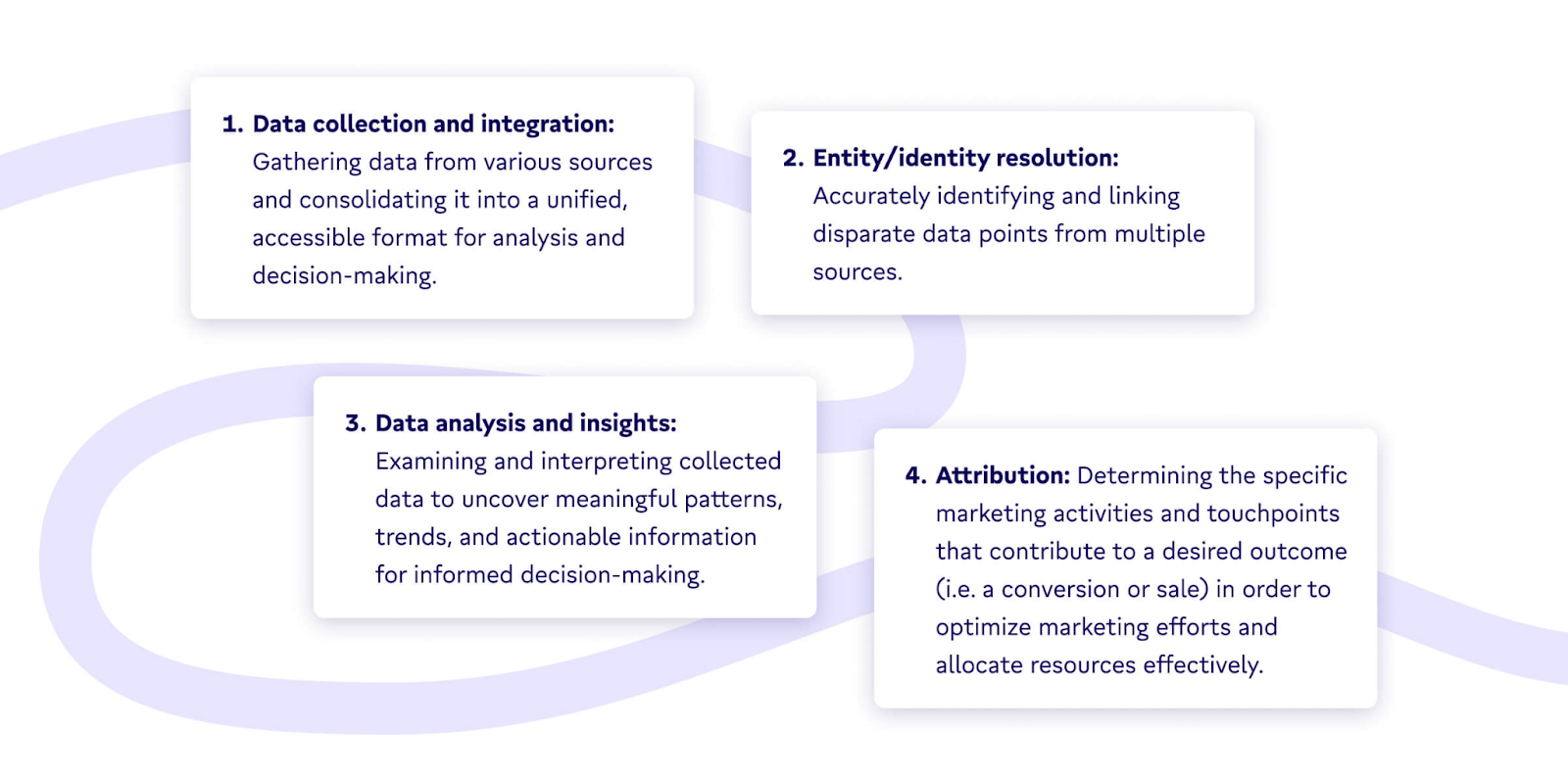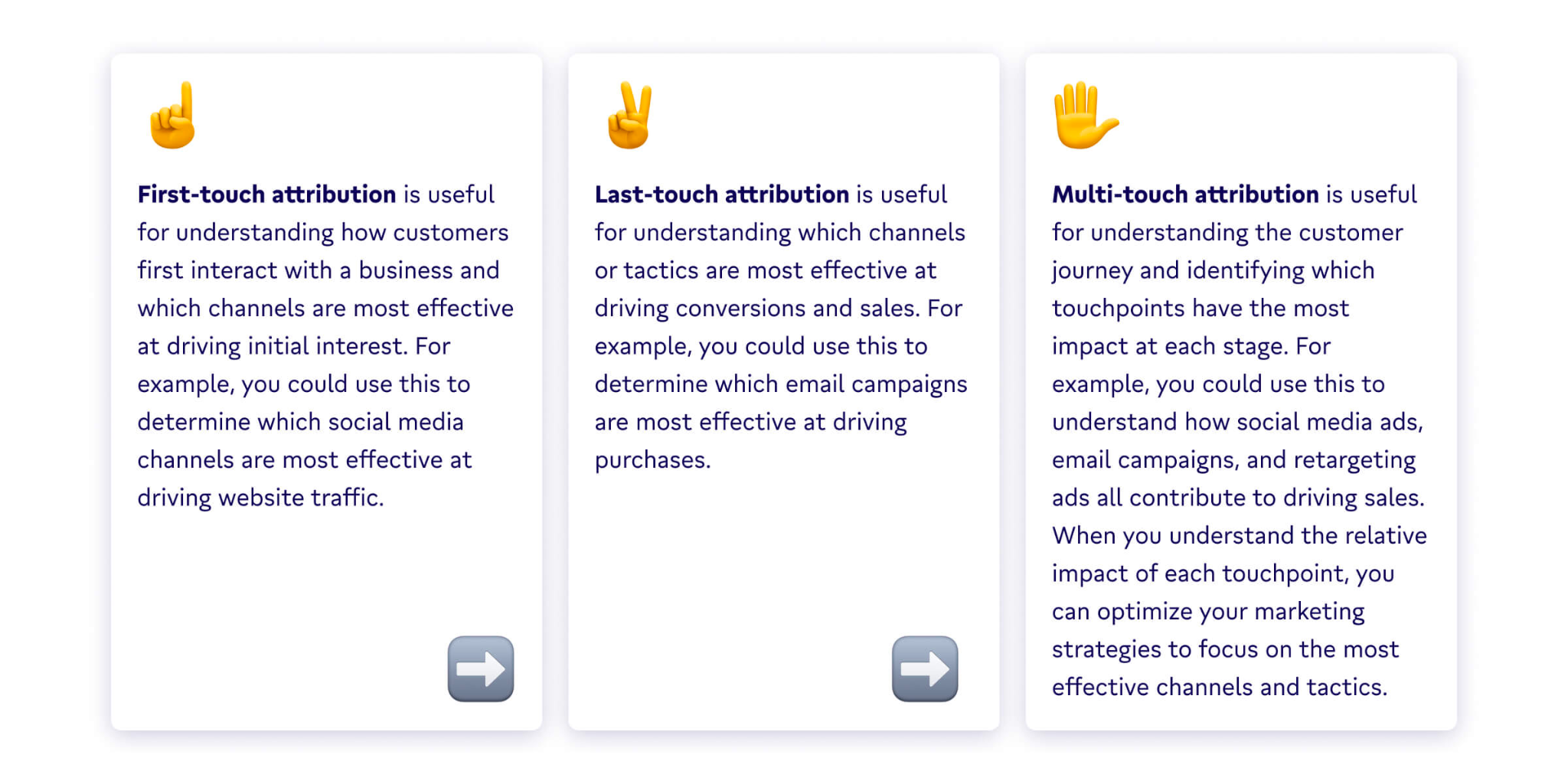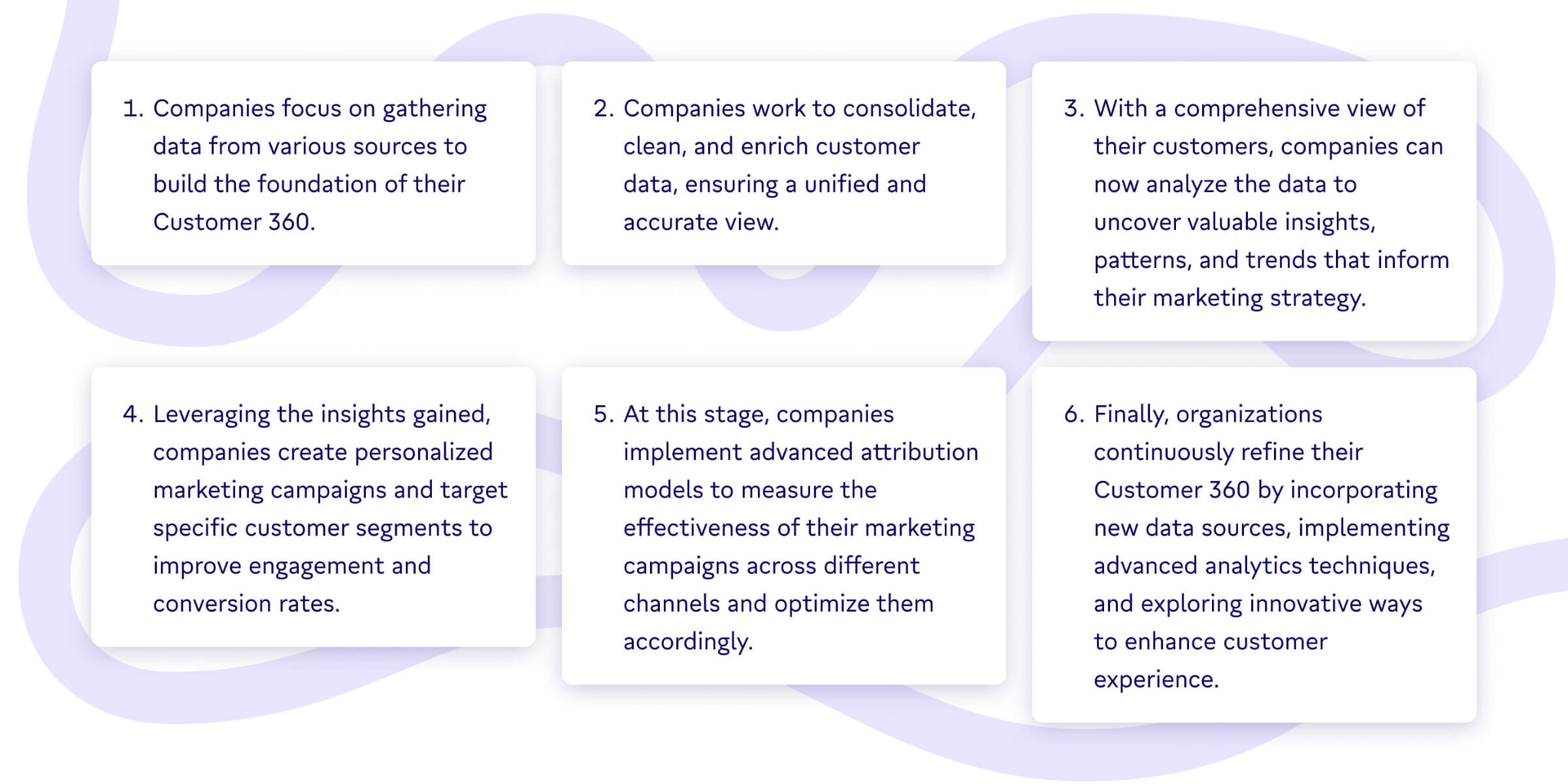Understanding your customers is huge. It’s the difference between tailoring your products to your customers and ignoring their identity altogether.
Hint: The former leads to increased satisfaction and loyalty and the latter results in lost business. 😞
Of course, this complete understanding of customers is important for all business units. For marketers who rely on customer insights to create effective marketing campaigns that impact the entire future of the business, however, this understanding can make or break all their efforts. And to truly and completely understand customers, you need a comprehensive view of them.
Coincidentally, a Customer 360 accepts this challenge, providing a comprehensive, unified view of your customers for a deeper understanding of their preferences, behaviors, and needs. Whether it’s website visits, social media activity, purchases, or customer service interactions, each customer interaction with your product provides another data point.
Traditionally, all these data points were funneled into a CDP. But the truth is, if you’re looking to paint an accurate 360° picture of your customer, this information isn’t nearly enough.
CDPs do ingest data — but most CDPs don’t have any of the customer or company-level data you need to draw conclusions about the buyer journey. At best, they’re allowing you to paint an incomplete picture of your customer; at worst, a wholly inaccurate one. 🎨
Instead, all data and business logic should be centralized around a solution that costs less and delivers far more: The data warehouse. With a warehouse-centric approach, you can use warehouse-native, best-in-class components to create a tool that ingests, unifies, segments, and activates your data — all without the restrictions and drawbacks of an out-of-the-box tool.
By collecting and consolidating data from each of these touchpoints in your data warehouse, you can better understand their preferences and needs (and tailor your marketing, sales, and customer service efforts accordingly).
In this article, we'll explore what a Customer 360 is, how it works, and the importance of adopting a maturity model to maximize its potential.
What does a Customer 360 really show? How do you create one?
A Customer 360, also known as a 360-degree customer view, is a comprehensive and holistic representation of a company's customers, integrating data from various touchpoints and channels. It provides valuable insights into customer behavior, preferences, and demographics, enabling businesses to deliver targeted, personalized messages and offers to improve customer experience, streamline marketing efforts, and drive revenue growth.
To build a true Customer 360, you need 4 main components: Data collection and integration, entity/identity resolution, data analysis and insights, and attribution.

|
Let’s take a look at what goes into each of these components, and why they matter to making your customer data dreams come true.
1. Data collection and integration
Data going into a Customer 360 can be both structured and unstructured, from internal and external sources alike. Structured and unstructured data represent the various information formats that marketers can collect, analyze, and use to drive marketing decisions and strategies. So, let’s break it down.👇
Structured data is information organized in a predefined format, which makes it easily searchable, quantifiable, and analyzable. This type of data typically fits into databases or spreadsheets, containing clearly defined fields and values which might include:
- Demographic information: Businesses can use demographic information, such as age, gender, location, and income, to tailor their marketing campaigns to specific customer segments.
- For example, they can create targeted ads or promotions that appeal to customers in certain age groups or income levels.
- Purchase history: Businesses can use purchase history data to offer personalized recommendations or discounts. By analyzing what products or services customers have purchased, how often they make purchases, and how much they spend, businesses can tailor their marketing campaigns to specific customer segments.
- For example, they can recommend products that complement a customer's previous purchases or offer discounts on items they frequently buy.
- Browsing behavior: Businesses can personalize interactions with browsing behavior by analyzing customers' online activity, such as which pages they visit, how long they stay on each page, and what actions they take. Using this data, businesses can tailor their marketing campaigns to specific customer segments.
- For example, they can offer personalized recommendations or promotions based on the products or services customers have shown interest in, or they can create targeted ads that appeal to customers who have viewed specific pages or taken certain actions on their website.
Unstructured data, on the other hand, is information without a specific format or structure. It’s more complex and often text-heavy, posing challenges for analysis using traditional database tools which includes:
- Customer support interactions: By using the information gathered from customer inquiries, complaints, and feedback, businesses can gain insights into the needs, preferences, and pain points of their customers. This information can then be used to personalize support interactions and improve the overall customer experience.
- For example, if a business identifies that a particular customer is consistently dissatisfied with their support experience, they can take proactive measures to address their concerns and improve their satisfaction level.
- Social media activity: This includes data about customers' engagement with a brand on social media, such as likes, comments, shares, and mentions. Using this data, you can meet customers where they visit the most with targeted ads that appeal to customers who have viewed specific pages, or simply just engage with them and build brand loyalty.
- For example, by knowing which social media platforms folks are using, businesses can respond to customers' comments or messages in a timely and personalized manner to show customers that their opinions and feedback are valued.
Imagine you're an e-commerce marketing manager aiming to create a personalized marketing campaign.
You need a comprehensive customer view, so you collect structured data like demographic information, transactional data, and engagement metrics. And to understand customers' sentiments and preferences, you gather unstructured data from social media platforms, customer reviews, and conversations between customers and your support or sales teams.
By combining structured and unstructured data in your Customer 360, you obtain a holistic understanding of your customers. While structured data offers valuable insights into customer behavior and preferences, unstructured data provides a deeper understanding of customer sentiment, pain points, and motivations. With both in tandem, you have the power to tailor your marketing campaign to their needs and preferences, and ultimately drive higher engagement and conversion rates.
And with Census, you can power your Customer 360 with every data point you need by enriching your warehouse with third-party data. In fact, building complete Customer 360 profiles has never been easier or more seamless with contact and company enrichment from our partners Clearbit and Apollo.
2. Entity and identity resolution
Entity and identity resolution are complex processes that involve matching customer data across different sources and reconciling any inconsistencies or discrepancies to create a unified customer profile. Here are some definitions to be aware of:
- Identity resolution: The process of linking customer records from multiple sources based on common identifiers, such as email addresses, phone numbers, or other unique identifiers. This can be done manually, but it is often more efficient to use automated algorithms or machine learning techniques to match and merge records.
- Entity resolution: Takes identity resolution a step further by using more advanced techniques to identify relationships between records and group them into a single customer entity. This involves analyzing data patterns, relationships, and attributes to identify which records belong to the same customer, even when there are no common identifiers.
For example, two records might have different email addresses, but the same IP address and purchase history. By analyzing these patterns and relationships across large volumes of data using entity resolution, you can identify that these records belong to the same customer.

|
3. Data analysis and insights
Integrating customer data reveals valuable insights into customer behavior, preferences, and demographics. By recognizing patterns and trends from multiple data sources, you can make informed decisions about marketing strategies and customer engagement initiatives. For example:
- Analyzing purchase history data helps you identify popular products or services among specific customer segments, allowing you to customize your marketing campaigns.
- Examining browsing behavior data highlights the pages or products that customers show the most interest in, enabling targeted promotions or recommendations.
- Reviewing customer support interactions uncovers common pain points or issues, empowering you to take proactive measures to enhance the overall customer experience.
And incorporating AI/ML models into your data analysis further refines your understanding of customer behavior. These models can predict a customer's propensity to buy by analyzing patterns in their past interactions, browsing behavior, and purchase history.
For instance, say you're on the marketing team at an online clothing store that’s aiming to boost sales. You integrate customer data from various sources, finding that the 25-34 age group frequently purchases eco-friendly clothing and visits related product pages.
Then you use AI/ML models to predict customers' propensity to buy based on past interactions, browsing behavior, and purchase history. With these insights, you launch a targeted marketing campaign focusing on eco-friendly products for customers in that identified 25-34 age group who show a high propensity to buy.
Leveraging integrated data and AI/ML models, you focus marketing efforts on customers with a high likelihood of converting, so your campaign effectively reaches the right audience with the right message. As a result, you not only drive increased sales, but optimize your marketing budget along the way.
4. Attribution.
Tracking and measuring the effectiveness of marketing campaigns and channels to understand their impact on customer engagement, conversion, and retention. Attribution involves tracking and analyzing each touchpoint that a customer has with a business before making a purchase or taking a desired action. This allows businesses to understand which channels or tactics are most effective in driving conversions and which may need improvement.
There are several ways to attribute credit to specific touchpoints, including first-touch attribution, last-touch attribution, and multi-touch attribution.

|
In general, by leveraging attribution data, you can optimize your marketing budget allocation and channel strategies to focus on the most effective tactics.
For instance, if you're a marketing manager at an online electronics store seeking to optimize your marketing strategy, you’d use attribution to track and analyze customer touchpoints before making a purchase or taking a desired action.
Naturally, you’ll start with first-touch attribution, and discover that Instagram is the most effective channel for driving website traffic. You then apply last-touch attribution, where you find that specific email campaigns effectively drive purchases. Finally, you implement multi-touch attribution to understand how Instagram ads, email campaigns, and retargeting ads contribute to driving sales.
After pulling each of those attribution levers, you see that Instagram ads drive more conversions than email campaigns, so you adjust your budget to prioritize social media. And when all is said and done, you have a nicely-wrapped customer package with everything you need to know about your customers. 🎁
Evaluate where you’re at in the Customer 360 journey with a Customer 360 maturity model
A Customer 360 maturity model is a framework that guides companies through the stages of implementing and optimizing their 360-degree customer view. Think of it as a roadmap to success.
By following this model, organizations can assess their current level of maturity, identify gaps, and develop strategies to advance through the stages. The maturity model typically consists of several stages:

|
See it in action
The power of a Customer 360 is best demonstrated through real-world use cases. Here are just a few examples of how businesses can leverage a Customer 360 to drive better business outcomes.
Personalized product recommendations
By analyzing customer behavior and purchase history, a Customer 360 can help companies create tailored product recommendations that resonate with individual preferences, boosting sales and customer satisfaction. For example, an e-commerce company can use a Customer 360 to recommend products that complement a customer's previous purchases or align with their browsing history. It’s the difference between personalizing your recommendations send customers stuff they’re actually interested in and being unsubscribed because what you’re sending is irrelevant.
Targeted email campaigns
A Customer 360 can inform targeted email marketing campaigns, ensuring that customers receive relevant, timely content. For instance, a B2B company can segment their customers based on industry, company size, or job role, and then send personalized content, promotions, or event invitations to each segment.
Improved customer support
By providing customer support representatives with a complete view of each customer's history and interactions, a Customer 360 enables faster, more personalized support experiences. For example, when a customer contacts a B2C company's support team, the representative can quickly access the customer's purchase history, past support tickets, and even social media interactions to better understand their needs and provide tailored assistance.
Optimized marketing budget allocation
With a clear understanding of which marketing channels drive the best results, companies can optimize their marketing budget allocation to maximize ROI. A Customer 360 provides insights into the most effective channels for customer acquisition, retention, and growth, allowing businesses to strategically invest in the tactics that yield the highest returns.
Reduced churn rates
A Customer 360 can help companies identify and target customers at risk of churn, enabling proactive engagement to retain valuable customers. By monitoring customer behavior, transaction patterns, and support interactions, businesses can identify signs of potential churn and take action to prevent it, such as offering personalized incentives or addressing specific concerns.
Let’s walk through exactly what this looks like with a hypothetical company, GreenTech Solutions. 🍃
GreenTech Solutions offers eco-friendly technology consulting and services to businesses. They’re scaling rapidly, and now they want to improve their customer engagement, conversion rates, and overall experience using a Customer 360. Here's how the Customer 360 maturity model guides them through implementation:
- GreenTech Solutions begins by gathering data from various sources such as website analytics, CRM, social media interactions, and email marketing platforms. They store this data in a centralized data warehouse to build the foundation of their Customer 360, ensuring a single source of truth for all customer-related information.
- They work diligently to consolidate, clean, and enrich customer data, ensuring a unified and accurate view of their clients and potential leads. That means merging duplicate records, correcting inconsistent data entries, and adding missing information from external sources like industry databases and business directories directly into the data warehouse.
- With a comprehensive view of their customers stored in the warehouse, GreenTech Solutions analyzes the data to uncover valuable insights, patterns, and trends that inform their marketing strategy. They identify which industries show the most interest in their services, the most common pain points their clients face, and the most effective content formats to engage their target audience.
- Leveraging these insights, GreenTech Solutions creates personalized marketing campaigns targeting specific customer segments. For example, they reach out to manufacturing companies interested in reducing their carbon footprint with tailored content and service offerings, such as whitepapers on sustainable manufacturing practices and case studies showcasing their successful projects.
- At this stage, GreenTech Solutions implements advanced attribution models to measure the effectiveness of their marketing campaigns across different channels, such as LinkedIn and Google Ads, and optimizes them accordingly. They use multi-touch attribution to understand the impact of various touchpoints like LinkedIn posts, search ads, and webinars on lead generation and conversion rates, all by analyzing the data in their warehouse.
- But their work is never done-done, so they continuously refine their Customer 360 by incorporating new data sources, implementing advanced analytics techniques, and exploring innovative ways to enhance the customer experience. They integrate data from new marketing channels like podcasts and virtual events, use AI-powered analytics on their warehouse data to predict customer behavior, and introduce personalized onboarding, account-based marketing strategies, and live webinars to engage with their clients and leads effectively.
In a world where customers have more choices than ever before, understanding their preferences and behaviors is essential for businesses to thrive. A Customer 360 is the key to unlocking this understanding, providing a comprehensive view of your customers' needs and preferences.
By adopting a maturity model and continuously refining your 360-degree customer view, you can optimize your marketing efforts, drive growth, and deliver personalized experiences that resonate with your customers. So, don't wait - take the first step in building your Customer 360 and start reaping the benefits of truly understanding your customers.
One comprehensive view, a lifetime of success
Ultimately, the warehouse-centric model — like the one described above — standardizes your consolidated, cleaned, and enriched customer data so you can leverage it in your downstream apps. And using a data activation platform like Census, you can easily sync this enriched data from your warehouse back to the specific, downstream business tools you use every day.
That way, all business users (i.e. sales, customer success, and marketing folks like us) have all the info they need to have informed customer interactions.
💡 Want to see how a data activation platform can unlock your data? See a preview from a Census product specialist.


















